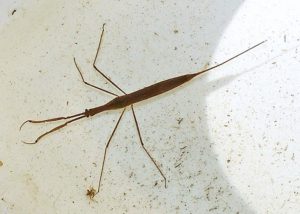Written by Woodland Dunes intern, Sydney Herman
At the beginning of my internship at Woodland Dunes, I made a few goals of skills I wanted to improve upon and topics to  learn about. I decided to explore the critters that live in the ponds at Woodland Dunes. In between programming and other duties, I tried to visit the pond at least five times throughout the summer and researched the specimens I caught.
learn about. I decided to explore the critters that live in the ponds at Woodland Dunes. In between programming and other duties, I tried to visit the pond at least five times throughout the summer and researched the specimens I caught.
Although often overlooked, ponds are home to a diverse assortment of aquatic plants and animals. The surface of a pond can be covered in duckweed, elodea, and various species of algae and bacteria. Hiding in or around the vegetation are macroinvertebrates and vertebrates. The animals that visit, or are found in ponds with vertebrae, are limited to birds, muskrats, mink, small fish, tadpoles, and frogs, while there is a massive diversity of invertebrates.
Ranging from crayfish to aquatic beetle-like creatures, there is no shortage of macroinvertebrates roaming the ponds. On an average day that I went scooping for pond life, I would catch dragonfly larva, giant water bugs, orb snails, the occasional backswimmer, and many other small creatures. Without prior knowledge or experience with this activity, it can be difficult to identify what you catch, so try finding resources such as a pond life dichotomous key to determine the names of your specimens.
My personal pond dipping experiences helped me lead and assist portions of family pond programs and a pond themed Nature Time Tuesday hosted by Woodland Dunes. I instructed the groups how to properly scoop their nets into the water and search them for small moving critters. Pond dipping is very popular among our young participants, so it was fun to watch them get excited about sifting through their nets for small fish and other creatures. One of my favorite moments was when a very young participant unknowingly scooped up two water scorpions. These aquatic invertebrates resemble the herbivorous walking stick; however, they are carnivorous, and their tail is used as a snorkel for breathing at the surface.
It is so easy to be distracted by larger ecosystems that we forget about habitats right under our noses. I’m reminded that even the smallest corners of a pond yield minuscule living things. If you are interested in learning more about the invertebrates living in ponds, all you need is a bucket and a net.
Image: Water Scorpion image from UW-Milwaukee Field Station
